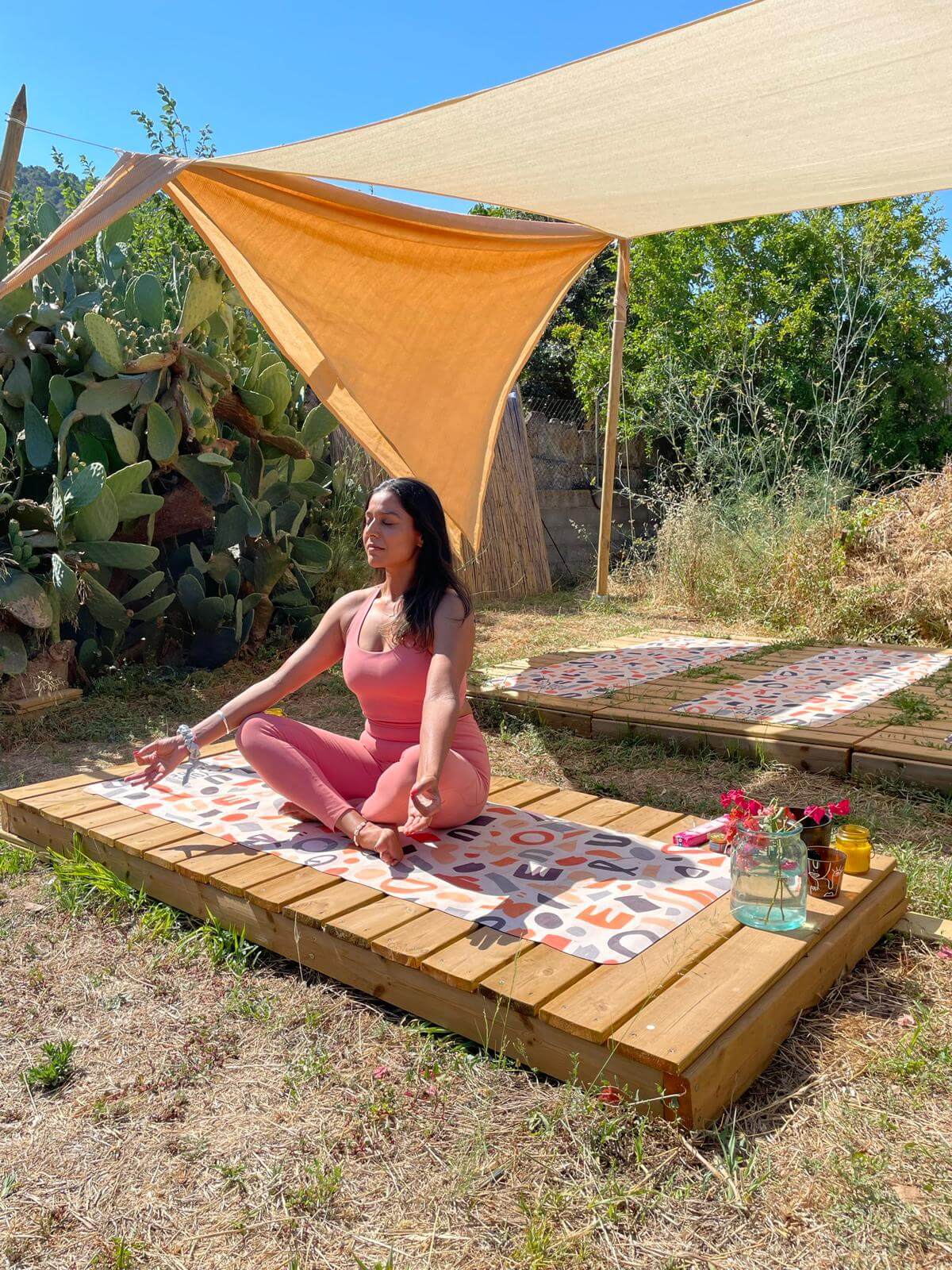If you’ve been thinking about taking up yoga and have started doing your research, you may well be feeling overwhelmed with the amount of information and resources there are out there, so we’re going to help you unpick that.
What is yoga
Vinyasa, hatha, ashtanga, Yoga with Adrienne! There’s certainly a lot out there to digest. But that’s not by accident. Yoga has a rich history rooted in tradition but has also developed and morphed into a wide range of practices, each with its own focus or style, and countless benefits – for your body, health and mental wellbeing. Yet, we all must start somewhere, and we don’t need to know it all either.
Dipping your toe into your first yoga class will give you a taste of what yoga is all about, and you can begin to reap the rewards immediately, whatever your goal or motivation. Don’t worry about the terminology -n inclusive and welcoming class will cover everything you need to know, and will continually guide you as you progress. Sometimes, finding the right LGBTQ+ yoga instructor can make all the difference to help you feel that sense of safety, freedom, and belonging, that we all need when starting a new class
The roots of yoga
The word yoga comes from the Sanskrit root yuj, meaning unite, and the practice essentially aims to create a harmony between the mind and body.
For many, there is a spiritual and meditative element which forms the foundation of their practice and helps to create this union.
Yoga originated in India as far back as 2700 BC and many different traditions and types of yoga have taken shape over the centuries. You can read a little more about the history of yoga here.

Nowadays, many millions of people around the world practise yoga, and you may have heard of some of these different types:
- Hatha yoga – a slower paced flow through a set of postures and breathing techniques
- Iyengar yoga – emphasises precision and alignment, often using props such as straps or blocks
- Vinyasa yoga – moving seamlessly between a series of postures using breath to guide you
- Bikram yoga – a fixed sequence of postures performed in a room heated to 41°C
- Yin yoga – a slow, meditative practice, holding poses for an extended period of time
- Restorative yoga – a relaxing and healing practice, holding poses for up to 20 minutes, with the aim of healing the body and mind
For a more detailed description of these, and other types of yoga, we recommend The Guardian’s Beginners Guide to Yoga.
Yoga Benefits
The benefits of yoga are well-known and well-researched; you can rest assured that whichever yoga journey you decide to embark on, you’ll be doing something amazing for yourself that you can’t regret.
What’s more, you don’t need to commit to several hours per week or wait months to enjoy its benefits. With yoga, you feel the benefits from day one and will do in every session. And, as with any discipline, the more you do it, the more you’ll get out of it. Once you’ve found the right space to settle into it, familiarise yourself with the techniques, movements, patterns, and postures, you’ll relax, focus inwardly, and find each practice works for you.
Benefits for the body
There is a reason yoga is so popular within fitness environments – it offers a wealth of physical benefits that you may never have even realised:
Whole body strength
For a start, yoga postures often stimulate the core region and major muscle groups in the legs, back and upper body. Holding, and moving through the postures at a slow pace, increases the time your muscles are under tension, leading to real improvements in whole body strength.
Improved breath
While holding postures, your breath helps you relax deeper into each stretch, enabling you to hold it for longer and develop deeper, full breaths.
Increased heart circulation
Although you may think of yoga as a more slow-paced, restful activity, faster practices like vinyasa can improve cardiovascular capability, burn energy, and improve heart health and increased stamina.
Increase range of motion, mobility, and flexibility
Whether you’re just starting on your fitness journey, or a seasoned athlete, yoga is an excellent way to complement your training and recovery because it supports joint health and flexibility, and can reduce inflammation.
The type and intensity of your chosen practice will always determine which areas you’ll most develop, but yoga will always support your overall fitness goals.
Yoga for runners
Yoga can be particularly beneficial for those who run, or incorporate running into their training program.
We love this article by Runner’s World, highlighting that ‘. Runners are often drawn to yoga to improve flexibility and reduce tightness in the hips and hamstrings. But yoga can also help to improve posture, mobility, strength, alignment and stability.’
Conversely, the article also states that evidence is ‘anecdotal . . . the science is yet to catch up’. The Professor they interviewed from the University of Gloucester, Athanassios Bissas, said there is no concrete evidence to demonstrate the benefits of yoga for runners. ‘Can yoga make you run faster? Not really. Can it make you stronger? There are other exercises to make you stronger,’ However, he did acknowledge yoga helps runners by surmising ‘Hypothetically it can help to improve range of motion but yoga is not better than a standard flexibility regime,’.
Yoga for new exercisers
If you’re new to exercise, yoga can be a wonderfully gentle introduction to movement, owing to it’s high levels of stretching and ease with which you settle into postures in your own time. Adaptations are offered to make sequences easier, or harder on days when you’re able to push further into a stretch, and instructors actively encourage rests wherever you need to.
Benefits to the mind
There is a reason yoga is so common amongst mental health practitioners, meditators, and spiritual healers:
Yoga for mental health
Yoga has a deep focus on breathing, as well as moments of stillness and relaxation, with a conscious awareness of how the body is feeling. It is these elements of meditation that give yoga the magical power of uniting our body and mind, and for many this is what sets it apart from other forms of exercise.
Yoga to still the mind of busy-people
Yoga helps manage stress because it enables us to regulate our emotional response to such stressors, and deal with them in a positive and constructive way. In particulate for those operating a fast-paced, busy schedule and are often tired and rushing around, including a yoga class into your day allows you to arrive at a place of stillness and quiet. Whether 20 minutes, or 45, you can truly unwind, forget your to-do list and give yourself your full attention. It’s a gift worth giving.
While yoga has been shown to help with mental health conditions such as depression or anxiety, it is important to remember that these benefits are supplementary to any medical or psychological treatment, and do not replace them.
Find queer yoga spaces for safety
If you’re a member of the LGBTQ+ Community, you’ll know that overall we deal with more than our fair share of stress and mental health conditions, and the proven link between yoga and mental health alone means it’s definitely worth giving it a try.
Whether you’re a beginner in yoga or are looking to progress and improve, finding a safe, welcoming and inclusive studio is incredibly important. Taking part in any form of exercise can feel quite exposing and can sometimes make us feel self-conscious about our bodies, how we move, how we look, or our abilities. We often feel different, or that we stand out and don’t fit in, and this can be a real barrier to accessing a valuable experience.
It is likely you feel more confident with a gay yoga trainer or a queer or lesbian yoga trainer, because they have that little more awareness of your potential needs or challenges, and will make sure everyone feels comfortable and included. There are also trans yoga instructors who will absolutely ensure that you are never made to feel excluded or othered – which can sometimes be an (usually) unintentional effect of being in a non-queer space.
Other LGBTQ+ Yoga Classes
We recommend this monthly Queer Yoga & Wellbeing class (based in Southend-on-Sea and on Zoom), Daniel and his team offer a truly respectful and inclusive space to practise yoga, focusing on gentle movement and breathing with a chance to reflect and share experiences with like-minded participants. These classes are suitable and adapted for all ages and physical abilities, and all genders are welcome and valued.
It is well worth looking into queer yoga spaces as these can truly help you to put aside any barriers and find a deeper connection with the practice as well as that sense of belonging that so many of us are striving for
{{locationDetails}}

